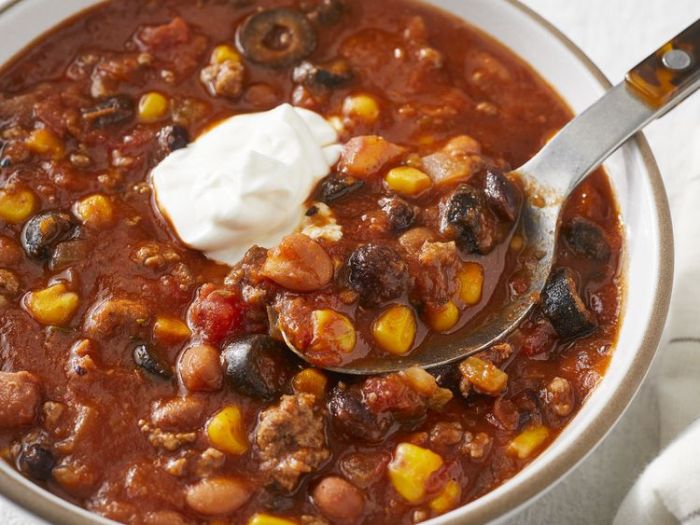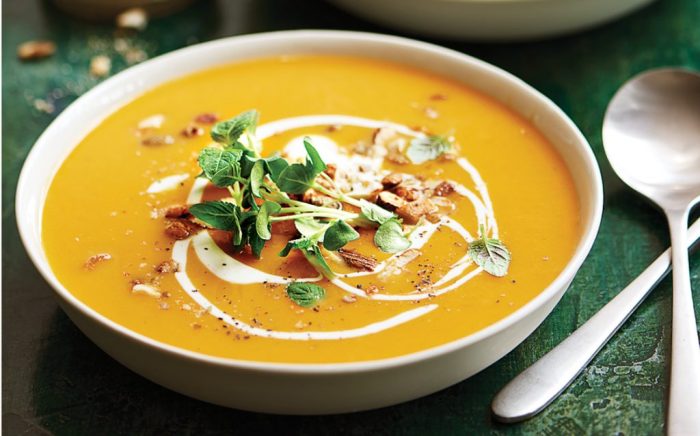Seafood Soup Variations
Recipe seafood soup – Seafood soups boast a remarkable diversity, reflecting regional culinary traditions and the bounty of the sea. Their variations are vast, ranging from creamy chowders to light and brothy concoctions, each with its unique character and flavor profile. This section explores several popular seafood soup recipes, their origins, and a comparison of two iconic examples.
Diverse Seafood Soup Recipes
The following table highlights the diversity found in seafood soups worldwide, showcasing different primary seafood, broth types, and key spices.
| Name | Primary Seafood | Broth Type | Key Spices |
|---|---|---|---|
| New England Clam Chowder | Clams | Creamy milk/cream broth | Salt, pepper, thyme |
| Bouillabaisse | Various fish (rockfish, scorpionfish, etc.) and shellfish | Fish stock, tomato | Saffron, fennel, garlic |
| Cioppino | Mixed seafood (shrimp, mussels, clams, crab, fish) | Tomato broth | Garlic, oregano, basil |
| Seafood Bisque | Shrimp, lobster, crab | Creamy broth | Sherry, thyme, bay leaf |
| Gazpacho Andaluz (cold seafood soup) | Shrimp, mussels, crab | Vegetable broth, tomato | Garlic, sherry vinegar, olive oil |
Regional Origins and Cultural Significance of Seafood Soups
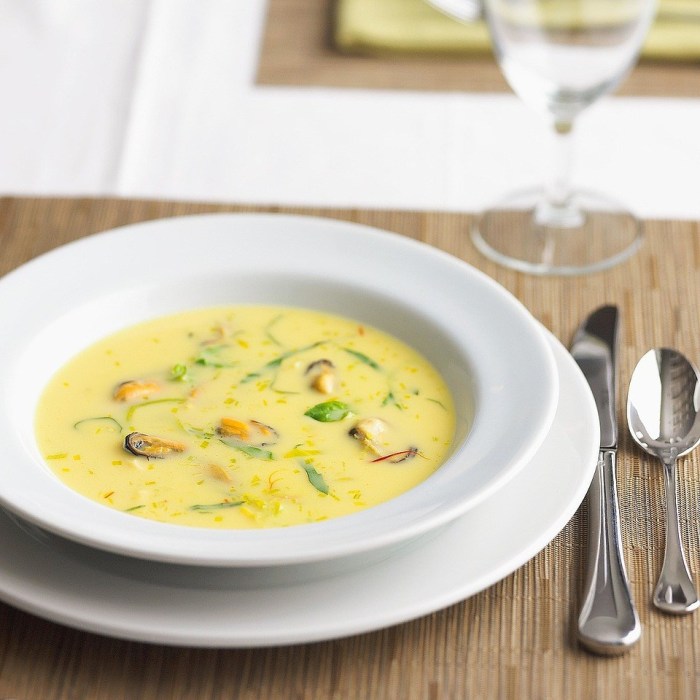
Source: media-allrecipes.com
Three distinct seafood soups illustrate the rich cultural tapestry woven into culinary traditions. Their historical context and significance are explored below.
New England Clam Chowder: Originating in New England, USA, this creamy soup reflects the region’s historical reliance on seafood. Its development is linked to the abundance of clams along the coast and the adaptation of European culinary techniques to local ingredients. The thick, creamy texture and use of potatoes are hallmarks of this regional favorite.
Bouillabaisse: Hailing from Marseille, France, bouillabaisse boasts a history deeply intertwined with the city’s fishing heritage. Historically a dish of the working class, utilizing less desirable fish, it evolved into a sophisticated culinary creation. Its rich, complex flavor profile is a testament to the Mediterranean’s abundance of fresh seafood and herbs.
Cioppino: A San Francisco Bay Area classic, Cioppino reflects the city’s diverse culinary influences. Developed by Italian immigrants, it incorporates a variety of seafood reflecting the region’s rich marine life. The tomato-based broth and blend of herbs provide a robust, flavorful experience.
Comparing New England Clam Chowder and Bouillabaisse
New England Clam Chowder and Bouillabaisse, despite both being seafood soups, offer vastly different flavor profiles. The creamy, milky base of clam chowder, often enhanced with potatoes and bacon, creates a rich, comforting taste. In contrast, bouillabaisse’s complex fish stock, saffron, fennel, and a medley of seafood create a more intense, savory experience. The key ingredients responsible for their distinct tastes are the fundamental difference in broth and the choice of seafood and herbs.
Ingredient Selection and Preparation
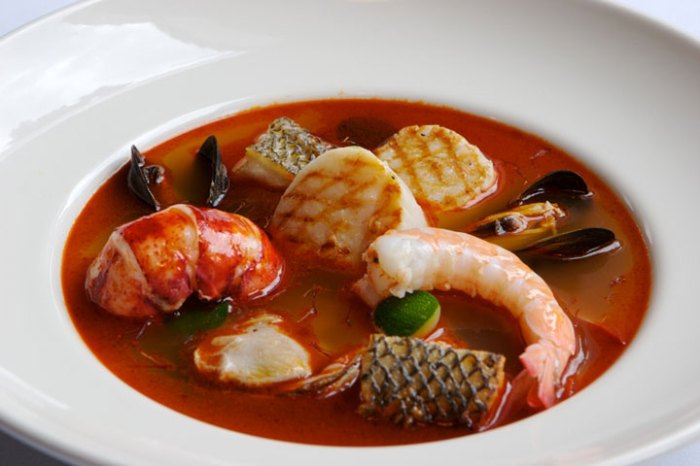
Source: cdkitchen.com
Selecting and preparing the ingredients correctly is crucial for a delicious and safe seafood soup. This section provides guidance on choosing fresh seafood, proper preparation techniques, and safe handling practices.
Selecting Fresh Seafood
Choosing high-quality, fresh seafood is paramount for creating a flavorful and safe seafood soup. Look for bright, clear eyes in fish, firm flesh that springs back when touched, and a fresh, mild odor. Shellfish should be tightly closed (or close when tapped) and have no unpleasant smell. Proper storage is equally important; refrigerate seafood promptly at 40°F (4°C) or below and use within one to two days of purchase.
Freezing is an option for longer storage, but remember that the texture might slightly change.
Preparing Seafood Ingredients
Proper preparation of seafood is essential for both flavor and food safety. The steps below Artikel the process:
- Cleaning Shellfish: Scrub shellfish thoroughly under cold running water using a brush to remove any dirt or debris. Discard any that are open and don’t close when tapped.
- Filleting Fish: Use a sharp knife to carefully fillet the fish, removing the skin and bones. Cut the fillets into bite-sized pieces.
- Chopping Vegetables: Chop vegetables like onions, carrots, and celery into uniform sizes to ensure even cooking.
Safe Seafood Handling
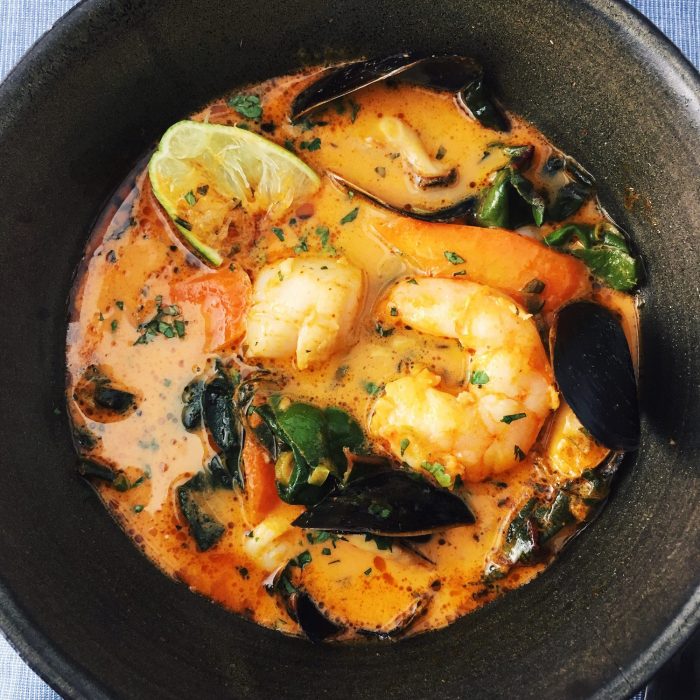
Source: nocrumbsleft.net
Proper seafood handling is crucial to prevent foodborne illnesses. Always thaw seafood safely in the refrigerator or by submerging it in cold water (changing the water every 30 minutes). Cook seafood to an internal temperature of 145°F (63°C) to ensure it’s safe to eat. Avoid cross-contamination by using separate cutting boards and utensils for raw seafood.
Broth and Flavor Development: Recipe Seafood Soup
The broth forms the foundation of any seafood soup, significantly impacting its overall taste and texture. This section explores various broth types, provides a fish stock recipe, and suggests spice combinations to enhance the flavor.
Types of Broths
Several broth types can be used in seafood soups, each imparting unique characteristics:
- Fish Stock: A rich, flavorful broth made by simmering fish bones, vegetables, and aromatics. It provides a deep, savory base.
- Vegetable Broth: A lighter, vegetarian alternative that offers a subtle sweetness and complements the seafood flavors.
- Court Bouillon: A flavorful liquid made with water, vinegar, wine, herbs, and spices, often used for poaching seafood.
Flavorful Fish Stock Recipe
This recipe yields a rich and flavorful fish stock:
Ingredients: Fish bones (from firm white fish), carrots, celery, onions, garlic, peppercorns, bay leaf, water.
Process: Roast the bones and vegetables until lightly browned. Combine all ingredients in a large pot, bring to a simmer, and cook for at least an hour, skimming off any foam that rises to the surface. Strain the stock through a fine-mesh sieve to remove solids.
Tip: For a deeper flavor, add a splash of white wine to the stock during simmering.
Spice Combinations for Seafood Soup
Five spice combinations that elevate seafood soup’s flavor profile are:
- Mediterranean: Oregano, basil, thyme, garlic, lemon zest.
- French Provençal: Saffron, fennel, thyme, bay leaf, garlic.
- Spicy Cajun: Cayenne pepper, paprika, garlic, onion powder, thyme.
- Asian-inspired: Ginger, garlic, lemongrass, soy sauce, fish sauce.
- Classic: Bay leaf, black peppercorns, salt, parsley.
Serving and Presentation
The presentation of a seafood soup significantly enhances the dining experience. This section explores creative garnishes, complementary side dishes, and ideal serving temperature.
Creative Garnishes, Recipe seafood soup
Three garnishes that enhance both the visual appeal and flavor of seafood soup are:
A sprinkle of fresh herbs, such as parsley, dill, or chives, adds a pop of color and a fresh, herbaceous note.
A drizzle of high-quality olive oil introduces a rich, fruity flavor and adds a beautiful sheen to the soup.
A squeeze of fresh lemon juice brightens the overall flavor and adds a touch of acidity to balance the richness of the soup.
Complementary Side Dishes
Five side dishes that pair well with seafood soup are:
- Crustacean Salad: A light salad featuring shrimp, crab, or lobster meat, offering a refreshing contrast to the soup.
- Garlic Bread: Toasted bread rubbed with garlic and herbs, providing a savory and satisfying accompaniment.
- Grilled Asparagus: Tender asparagus spears grilled to perfection, offering a fresh, slightly bitter counterpoint.
- Quinoa Salad: A healthy and flavorful salad with quinoa, vegetables, and a light vinaigrette.
- Simple Green Salad: A classic green salad with a light vinaigrette, offering a fresh and cleansing element.
Ideal Serving Temperature
Seafood soup is best served hot, but not boiling. Maintaining its optimal temperature can be achieved by using a warming plate or chafing dish for larger gatherings. For individual servings, a pre-heated bowl can help maintain warmth.
Recipe Adaptations and Variations
Seafood soup recipes are easily adaptable to cater to diverse dietary needs and preferences. This section explores variations for different diets and methods for adjusting the recipe based on seasonal ingredients.
Dietary Adaptations
Three variations of a basic seafood soup recipe cater to different dietary requirements:
- Vegetarian: Substitute seafood with hearty vegetables like mushrooms, artichoke hearts, and zucchini. Use vegetable broth as the base.
- Gluten-Free: Ensure all ingredients, including the broth and any seasonings, are certified gluten-free. Avoid using thickened broths containing gluten-based ingredients.
- Low-Sodium: Use low-sodium broth and reduce the amount of salt added. Season with herbs and spices to enhance flavor without relying heavily on salt.
Adjusting Cooking Times and Methods
Cooking times vary depending on the type of seafood used. Delicate seafood like shrimp and scallops cook quickly, while firmer fish like cod or halibut require longer cooking times. Adjust cooking times accordingly to prevent overcooking and maintain optimal texture. Different cooking methods, such as poaching, simmering, or steaming, can also impact the final product.
Adapting to Seasonal Ingredients
Seasonal ingredients add freshness and vibrancy to seafood soup. Incorporate seasonal vegetables such as summer squash, tomatoes, or root vegetables in the fall. Utilize seasonal seafood, like soft-shell crabs in the summer or monkfish in the winter. This ensures optimal flavor and availability of ingredients.
FAQ Corner
Can I freeze leftover seafood soup?
Yes, seafood soup freezes well. Allow it to cool completely before storing in airtight containers. It can be stored in the freezer for up to 3 months.
What are some good substitutes for fish stock?
Vegetable broth or chicken broth can be used as substitutes for fish stock, although the flavor will be different. You might need to add extra seasonings to compensate.
How can I tell if my seafood is fresh?
Fresh seafood should have a mild, pleasant smell, not fishy or ammonia-like. The flesh should be firm and elastic, and the eyes should be clear and bright (for whole fish).
What type of pot is best for making seafood soup?
A large, heavy-bottomed pot, such as a Dutch oven or stockpot, is ideal for making seafood soup, as it ensures even heating and prevents scorching.

